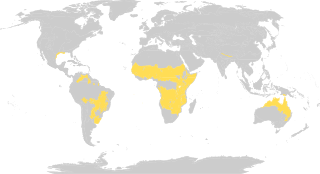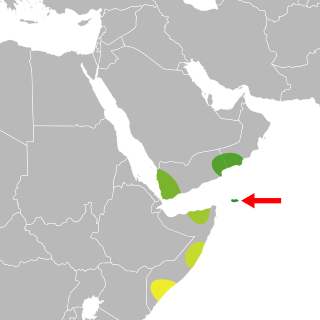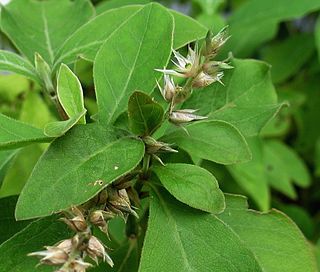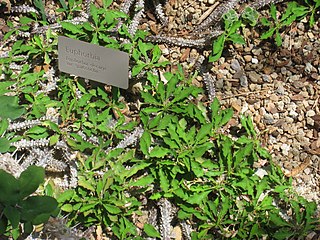
Tropical and subtropical grasslands, savannas, and shrublands is a terrestrial biome defined by the World Wide Fund for Nature. The biome is dominated by grass and/or shrubs located in semi-arid to semi-humid climate regions of subtropical and tropical latitudes. Tropical grasslands are mainly found between 5 degrees and 20 degrees in both North and south of the Equator.
Hawaiian hibiscus are seven species of hibiscus native to Hawaii. The yellow hibiscus is Hawaii's state flower. Most commonly grown as ornamental plants in the Hawaiian Islands are the non-native Chinese hibiscus and its numerous hybrids, though the native Hibiscus arnottianus is occasionally planted.

Zygocarpum is a genus of flowering plants in the legume family, Fabaceae. It includes six species of shrubs and small trees native to Somalia and Socotra, and to Yemen and Oman on the southwestern Arabian Peninsula. Three species are endemic to Somalia, two to the Arabian Peninsula, and one to Socotra. Typical habitats include seasonally-dry tropical woodland, thicket, and bushland, often on limestone and less often on granite-derived or sandy soils, up to 2000 meters elevation.

The red-capped crombec is a species of African warbler, formerly placed in the family Sylviidae.
Ayenia sparrei is a species of flowering plant in the family Malvaceae. It a shrub found only in Ecuador.
Leptolaena cuspidata is a species of flowering plant in the Sarcolaenaceae family. It is found only in Madagascar. Its natural habitats are subtropical or tropical dry forests and subtropical or tropical moist lowland forests. It is threatened by habitat loss.

Hypericum tortuosum is a species of flowering plant in the genus Hypericum. It is found only in Socotra, Yemen, where it is endemic. The species is an apomorphic relative of the other Socotran species in Hypericum sect. Triadenioides and is most closely related to Hypericum scopulorum. Its natural habitats are subtropical or tropical dry forests and subtropical or tropical dry shrubland.

Phlyctimantis maculatus is a species of frog in the family Hyperoliidae. They are silvery greyish-brown with dark brown to black spots, and derive their name from bright red coloring on the ventral side of their hind legs. Adult body length is typically 6 to 7.5 centimeters. These frogs have vertical pupils. Common names include red-legged running frog, brown-spotted tree frog, red-legged Kassina, red-legged pan frog, spotted running frog, tiger leg running frog, and vlei frog.

The Mascarene grass frog, or Mascarene ridged frog, is a species of frog in the family Ptychadenidae. It is found in sub-Saharan Africa, Madagascar, and Mauritius.

The masked lark is a species of lark in the family Alaudidae. It is found in Ethiopia and Kenya. Its natural habitats are subtropical or tropical dry shrubland and subtropical or tropical dry lowland grassland.

The yellow-whiskered greenbul or yellow-whiskered bulbul is a species of the bulbul family of passerine birds. It is found in western and central Africa.

The Aldabra flying fox is a species of megabat in the genus Pteropus. It is endemic to the Aldabra Atoll in the Seychelles, like Chaerephon pusilla, though the latter may be the same species as the little free-tailed bat.

Achyranthes mutica is a species of plant in the family Amaranthaceae. It is endemic to Hawaii. It is a perennial shrub that grows up to 2 ft (0.61 m) tall. Its natural habitats are dry forests and subtropical or tropical dry shrubland. It is threatened by habitat loss.

Euphorbia arbuscula is a species of plant in the spurge family (Euphorbiaceae). It is endemic to the archipelago of Socotra in Yemen. Its natural habitats are subtropical or tropical dry forests and subtropical or tropical dry shrubland.

Euphorbia decaryi is a species of plant in the family Euphorbiaceae endemic to Madagascar. Its natural habitats are subtropical or tropical dry forests, subtropical or tropical dry shrubland, and rocky areas. It is threatened by habitat loss.

Euphorbia socotrana is a species of plant in the family Euphorbiaceae. It is a tree or shrub endemic to Soqotra in Yemen.
Kraussia socotrana is a species of plant in the family Rubiaceae. It is endemic to Socotra, Yemen. Its natural habitats are subtropical or tropical dry shrubland and rocky areas. The type was collected from Wadi Irih on the Nogad Plain.

Pakistan's native flora reflects its varied climatic zones, which range from arid and semi-arid to temperate and tropical.

Bursera fagaroides is a species of flowering plant in the genus Bursera known by the common names torchwood copal and fragrant bursera. It is widespread across much of Mexico from Sonora to Oaxaca, and its range extends just into Arizona in the United States, although some sources suggest that it may now be extirpated in Arizona.

Alluaudia comosa is a rare species of flowering plant. It belongs to the family Didiereaceae, subfamily Didiereoideae, which is found only in the coastal area of SW Madagascar. Didierea comosa Drake is a synonym. It is listed as "vulnerable" on the IUCN Red List of Threatened Species.


















